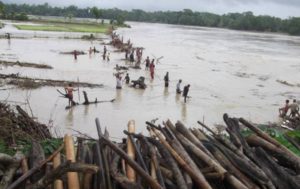Staff Correspondent | Jun 05,2022 New Age
In the 24 hours, until 9:00am Bangladesh time on Saturday, the India Meteorological Department said that the southwest monsoon caused 206 per cent excess rain compared to what was normal in Meghalaya, followed by 193 per cent above normal rain in Arunachal Pradesh, 90 per cent in Sikkim, 68 per cent in West Bengal, 30 per cent in Assam, 21 per cent in Nagaland and 8 per cent in Bihar.
Inside Bangladesh, the country’s highest rainfall of 158mm over the same reporting period was recorded at Sunamganj, followed by 125mm at Chhatak in Sylhet.
Above 50mm rainfall was recorded at many places in northern, northeastern and southern regions.
According to the Flood Forecasting and Warning Centre, generally, 50mm or above rainfall in one day causes stress for local drainage system leading to a localised flood.
A 300mm or more rainfall in consecutive 10 days impedes drainage and is likely to cause rain-fed flood in the area, the FFWC said.
The Teesta, the Dharla, the Surma, the Kushiyara, and the Someswari rivers might cause flooding in the next 48 hours, depending on the rain upstream across the border, said the FFWC bulletin issued on Saturday afternoon.
Out of 109 river gauging stations, 52 reported a rise in water level, it said.
‘Rain will continue as this is the beginning of monsoon,’ observed meteorologist Abdul Mannan.
The Department of Agricultural Extension said that over 90 per cent of boro cultivated on 49.63 lakh hectares of land across Bangladesh had been reaped.
Parts of the north-eastern areas have already endured three waves of flash flooding since the first week of April.
Thunderstorms also damaged crops across the country between April and May.
A total of 21,000 hectares of standing boro crop has completely been damaged due to flooding and thunderstorm, according to the DAE estimation.
The official estimate is believed to be an underestimation, according to a haor-based NGO that reported four times as much in loss of crops due to flood as the official record after the second wave of flash flooding swept the northeastern districts.










